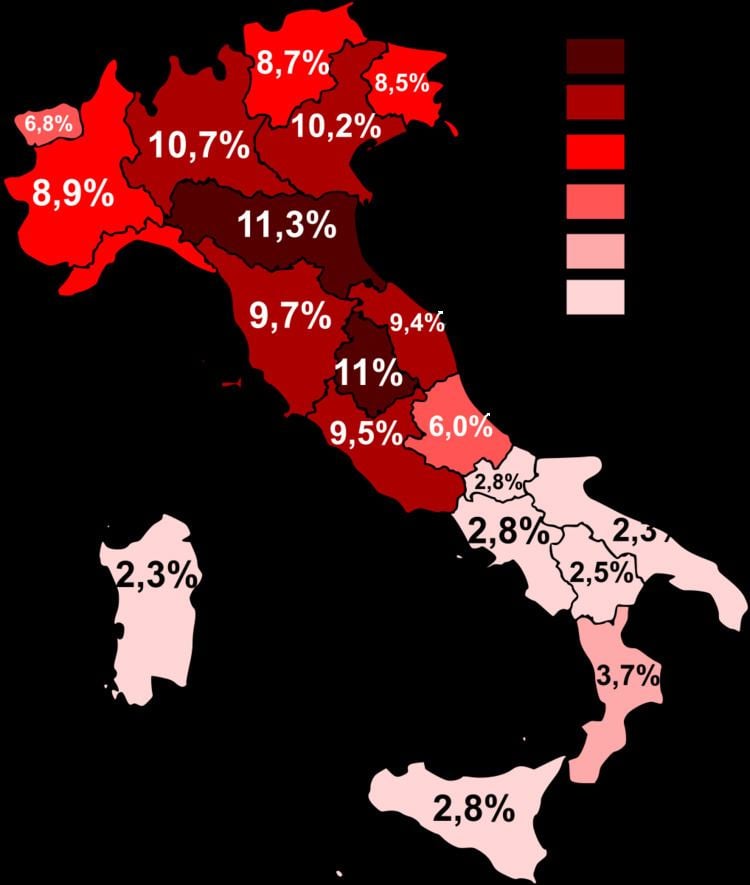 | ||
Immigration to Italy occurs from a variety of countries.
As of 1 January 2015, there were 5,014,437 foreign nationals resident in Italy. This amounted to 8.2% of the country's population and represented an increase of 92,352 over the previous year. These figures include children born in Italy to foreign nationals (who were 75,067 in 2014; 14.9% of total births in Italy), but exclude foreign nationals who have subsequently acquired Italian nationality; this applied to 129,887 people in 2014. They also exclude illegal immigrants whose numbers are difficult to determine. In May 2008, The Boston Globe quoted an estimate of 670,000 for this group. The distribution of foreign born population is largely uneven in Italy: 59.5% of immigrants live in the northern part of the country (the most economically developed area), 25.4% in the central one, while only 15.1% live in the southern regions. The children born in Italy to foreign mothers were 102.000 in 2012, 99.000 in 2013 and 97.000 in 2014.
Many illegal immigrants from Africa make the dangerous boat journey across the Mediterranean Sea to Italy. This has led to numerous disasters such as the 2007 Malta migrant shipwreck, the 2009 Libya migrant shipwreck, the 2011 migrant shipwreck, the 2013 Lampedusa migrant shipwreck, and the 2015 Mediterranean Sea migrant shipwrecks. Once in Italy, immigrants seeking asylum often are unable to leave due to the Dublin Regulation requirement that they stay in the first country where they are processed.
Since the expansion of the European Union, the most recent wave of migration has been from surrounding European states, particularly Eastern Europe, and increasingly Asia, replacing North Africa as the major immigration area. About a million Romanians, around 10% of them being Roma, are officially registered as living in Italy. As of 2013, the foreign born population origin was subdivided as follows: Europe (50.8%), Africa (22.1%), Asia (18.8%), America (8.3%), and Oceania (0.1%).
Sea arrivals
Many immigration patterns to Italy have been noted, most for work purposes, especially after the economic boom of the European Nations after a few decades of World War II. Due to this booming economy, the European nations began to seek manpower for their workforce, and began looking to migrant workers. In Italy, the first waves of migrant workers began in the 1970s when many migrant workers sought easy to find and informal recruitment jobs such as the fishing industry on the Island of Sicily. Another wave of the earliest groups to travel to Italy were the Filipino. Many women came to Italy to work in domestic and care-taker jobs in order to provide for their families back home.
Since the early 2000s, the small island of Lampedusa has become a prime transit point for immigrants and asylum seekers from Africa, the Middle East and Asia wanting to enter Europe. In 2004, the Libyan and Italian governments reached a secret agreement that obliged Libya to accept those deported from Italian territories. This resulted in the mass return of many people from Lampedusa to Libya between 2004 and 2005 without the endorsement of European Parliament.
By 2006, many immigrants were paying people smugglers in Libya to help get them to Lampedusa by boat. On arrival, most were then transferred by the Italian government to reception centres in mainland Italy. Many were then released because their deportation orders were not enforced.
In 2009, the overcrowded conditions at the island's temporary immigrant reception centre came under criticism by the United Nations High Commissioner for Refugees (UNHCR). The unit, which was originally built for a maximum capacity of 850 people, was reported to be housing nearly 2,000 boat people. A significant number of people were sleeping outdoors under plastic sheeting. A fire started as an inmate riot destroyed a large portion of the holding facility on 19 February 2009. Most of the immigrants were from Ghana, Mali and Nigeria and were working illegally as seasonal farm workers.
In 2008, Berlusconi’s government in Italy and Gaddafi’s government in Libya signed a treaty including cooperation between the two countries in stopping irregular migration from Libya to Italy; this led to a policy of forcibly returning to Libya boat migrants intercepted by the Italian coast guard at sea. The cooperation collapsed following the outbreak of the Libyan civil war in 2011, and in 2012 the European Court of Human Rights ruled that Italy had violated the European Convention on Human Rights by returning migrants to Libya, as it exposed the migrants to the risk of being subjected to ill-treatment in Libya and violated the prohibition of collective expulsions.
In 2011, many more immigrants came to Lampedusa during the rebellions in Tunisia and Libya. By May 2011, more than 35,000 immigrants had arrived on the island from Tunisia and Libya. By the end of August, 48,000 had arrived. Most were young males in their 20s and 30s. The situation has caused division within the EU, the French government regarding most of the arrivals as economic migrants rather than refugees in fear of persecution. The Libyan ambassador to Italy stated that Gaddafi controlled illegal immigration to meet his goals- "he wanted to turn Lampedusa black with Africans".
